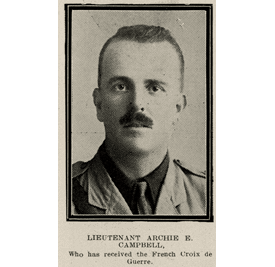Major A.E.G.Campbell
D.S.O M.C Croix de Guerre (French)
Twice mentioned in dispatches.
14th LIGHT HORSE REGIMENT
…In spite of the main body being deflected by another
order, this officer pursued what was described as a ‘very vigorous course’  through the gardens, clearing out 150 enemy and many machine guns before reaching the railway line…
through the gardens, clearing out 150 enemy and many machine guns before reaching the railway line…
Archie Campbell was born at “Cubbo Station”, Wee Waa, New South Wales on the 17th October, 1885. On enlistment as a trooper in the 2nd Light Horse Regiment (Qld) on the 19th August, 1914, he was employed as a business manager of Bridge & Co Ltd, Toowoomba.
Promoted to Squadron Quartermaster Sergeant on 1st December, 1915 and commissioned 2nd Lieutenant on the 11th February, 1916 and Lieutenant on the 15th June, 1916, promoted Captain on 20th April, 1917 and Major on the 1st July, 1918.
In June of 1916, he transferred to the Camel Corps, joining the 3rd (Anzac Camel Bn in November, 1916, then the 1st (Anzac) Camel Bn in April, 1917. He was acting adjutant of the 1st Camel Brigade Headquarters from the 1st February, 1918 until he joined the 14th Light Horse Regiment on the 1st July, 1918.
Major Campbell was one of the most decorated Light Horsemen of the 1st AIF. He was awarded the Military Cross (MC) for gallantry in Sinai and Palestine on the 19th April, 1917 and the Distinguished Services Order (DSO) on the 30th September, 1918 at Salahiye (Damascus).
Citation/London Gazette,4 October,1919, for DSO
Maj. Archie Eric Gordon Campbell, M.C., 14th A.L.H.R. (Egypt).
For distinguished leadership and devotion to duty. On the 30th September, 1918, at Salahiye (Damascus), he was charged with the work of clearing the gardens to the south of the village, in expectation of the whole force following. In spite of the main body being deflected by another order, this officer pursued a very vigorous course through the gardens, clearing out 150 enemy and many machine guns before reaching the railway line. He also did very valuable work in consolidating the position taken up across the road. Throughout the operation his work was excellent.
On returning to civilian life after the war from 1914-18, Major Campbell became the A.M.P. representative at Toowoomba and later Dalby (Qld), retiring in 1950 to live at Tamborine Mountain till he passed away in 1963.
Major Campbell is the father of our patron, Sir Walter Campbell AC. QC, to whom I am truly grateful for this splendid information.
| Regimental number | 309 |
| Date of birth | –/02/1886 |
| Religion | Church of England |
| Occupation | Manager |
| Marital status | Single |
| Age at embarkation | 29 |
| Next of kin | Mother, Mrs Anne F. Campbell, Wee Waa, New South Wales |
| Enlistment date | 19 August 1914 |
| Rank on enlistment | Private |
| Unit name | 2nd Light Horse Regiment, B Squadron |
| AWM Embarkation Roll number | 10/7/1 |
| Embarkation details | Unit embarked from Brisbane, Queensland, on board Transport A15 Star of England on 24 September 1914 |
| Regimental number from Nominal Roll | Commissioned |
| Rank from Nominal Roll | Major |
| Unit from Nominal Roll | 14th Light Horse Regiment |
| Promotions | 2nd Lieutenant
Unit: LH2
Promotion date: 1 February 1916 Lieutenant Unit: Camel Corps
Promotion date: 15 June 1916 |
| Recommendations (Medals and Awards) | Military Cross
Recommendation date: 19 April 1918
Distinguished Service Order Recommendation date: 19 September-3 October 1918
Mention in Despatches Awarded, and promulgated, ‘London Gazette’, Supplement, No. 31383 (5 June 1919); ‘Commonwealth Gazette’ No. 72 (2 September 1920).
Mention in Despatches Awarded, and promulgated,’London Gazette’ No 31938 (11 June 1920); ‘Commonwealth Gazette’ No 72 (2 September 1920).
Mention in Despatches Awarded, and promulgated, ‘London Gazette’, No. 30474 12 January 1918); ‘Commonwealth Gazette’ No. 75 (17 June 1919).
|
| Returned to Australia 15 November 1918 | |
| Medals | Distinguished Service Order
‘For distinguished leadership and devotion to duty. On the 30th September, 1918, at Salahiye (Damascus), he was charged with the work of clearing the gardens to the south of the village, in expectation of the whole force following. In spite of the main body being deflected by another order, this officer pursued a very vigorous course through the gardens, clearing out 150 enemy and machine guns before reaching the railway line. He also did very valuable work in consolidating the position taken up across the road. Throughout the operations his work was excellent.’
Source: ‘Commonwealth Gazette’ No. 10 Date: 29 January 1920 Croix de Guerre (France) Source: ‘Commonwealth Gazette’ No. 174
Date: 11 October 1917 Military Cross Source: ‘Commonwealth Gazette’ No. 57
Date: 18 April 1918 |
